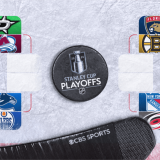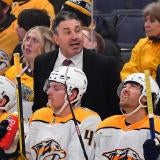
In the tiny hamlet of Lake Placid, NY, 35 years ago, 20 amateur hockey players stepped foot on Olympic ice and beat the juggernaut that was the Soviet Union hockey team. It was a win that was dubbed miraculous in a sequence of words that many American hockey fans can recite from memory.
"Eleven seconds, you've got 10 seconds, the countdown going on right now," as Al Michaels' near-breathless iconic call goes. "Morrow up to Silk. Five seconds left in the game. Do you believe in miracles? Yes!"
It was the iconic call for an iconic moment in sports history and even 35 years later, it remains as perhaps the greatest moment in American sports period.
But as time passes, it's easy to remember the "Miracle" and its biggest moments: Mike Eruzione's goal with 10 minutes to play to give the United States a 4-3 lead, Michaels' perfect call of the final seconds will stand the test of time.
Though the 35th anniversary seems like an arbitrary number to commemorate this incredible feat, the 19 living members of Team USA were all back in Lake Placid for the first time since winning the gold for a reunion Saturday night. After losing defenseman Bob Suter to a heart attack last summer, it was a stark reminder time may no longer be on the side of the 20-somethings who shocked the world in 1980.
As someone who was not alive for this major moment, I decided to go back and watch the game from start to finish, pick things that stood out and pull some other interesting facts and figures from the game, the 20 players on Team USA and that 1980 Olympic tournament as a whole that often get overlooked amid the iconic moments of one of the greatest games in sports history.
KEY MOMENTS
The Americans' stunning 4-3 victory over the Soviet Union becomes even more remarkable under closer examination. The fact that the US was able to stay in the game at all was a miracle in itself. Here's a look at how the US pulled off this remarkable victory.
Jim Craig's first period: Team USA faced an onslaught of 18 shots against in the opening period. I counted 14 legitimate scoring chances in the first period alone for the Soviets. Craig stood tall, stopping 16. The game could have easily been over by the time they got out of the first period as half of the 36 saves Craig made came in the opening stanza.
Mark Johnson's last-second goal: The Americans had no business going into the second period level with the Soviets and they wouldn't have if not for the heads-up play and overall hustle of Mark Johnson.
With about five seconds remaining in the first period, Dave Christian let go a bomb of a shot from the wrong side of the red line. The rebound bounced off of goalie Vladislav Tretiak's pads and right onto the stick of the hard-charging Johnson, who was simply playing to the whistle. Johnson collected the puck, made one deke and beat Tretiak with one second remaining on the clock. In most games, that's a nothing play that just goes without much notice. Instead, it was probably the most important goal of the entire thing.
Though Eruzione's goal is best remembered, and rightfully so, Johnson's goal is probably the most important scored in the game. Going into the locker room all tied up after giving up 18 shots in the first period was a miracle in itself.
Jim Craig's last half of the game: The Americans did a better job of limiting shots, but the Soviets put 12 on net in the second period. Team USA had two. After the Soviets took a 3-2 lead early in the second, Craig became a wall. He was rock solid between the pipes as Team USA did not allow a goal for the final 31:42 of game action, finishing with 36 saves against one of the greatest offensive teams in the world, NHL or otherwise.
To put Craig's performance in perspective, the Soviets had 71 percent of the shots on goal in the game. Given the circumstances, probably nine times out of 10, a team controlling play that handily is going to win.
Mike Eruzione's winner: Just 1:21 after Johnson tied the game after a defensive miscue gave him an open shot in the third period, Mike Eruzione took his place in sports history as the quintessential hero in the height of natural drama.
Eruzione can thank the great work on the forecheck by John Harrington and the well-placed stick of Mark Pavelich for opening the door for him to burst through.
After getting in on the forecheck, Harrington got a stick on one of the Russian players. The puck then bounced near Pavelich, who could only get a stick on it before one of the Soviets tried swatting it away. Pavelich went careening into the boards and the puck deflected into an open area of the ice just as Eruzione was getting there. It bounced right onto his blade.
From there, it was all Eruzione with an absolutely perfect shot that made it past a defenseman and just under the arm of Vladimir Myshkin -- the goalie who replaced Tretiak after the first period -- to make it 4-3. It was the right bounce at the right time.
Team USA's third-period defense: It is not often remembered just how much better the Americans played defensively in the third period. While trailing, they never strayed from shutting down the Soviets' remarkable transition game.
The Russians rarely would dump the puck in, so every time they tried to stickhandle into the zone, there were three Americans to meet them. That made for fewer shots on Craig and helped lead to more turnovers in the defensive zone that allowed the US transition to break out with some speed up the ice.
The back checking and the discipline from the Americans was just outstanding throughout the third period.
The Americans then had 10 minutes to keep the Soviets off the board after Eruzione scored. Again, they maintained a defense that frustrated the skillful Russians. Their chances, which were so plentiful early in the game, were few and far between in the third.
MEMORABLE STATS
Here's a look at some of the more interesting facts and figures from the game, the team and the tournament as a whole ...
33-15: Team USA's aggregate score in seven games. While the American kids were mostly college guys or low-minor leaguers, they could play. They went undefeated in the tournament and outscored their opponents by 18 goals. Even if the USSR was the best club on paper, the US was No. 2 -- though bronze-medalist Sweden could have been in the discussion, too.
63-18: USSR's aggregate score in seven games. So yeah, they were pretty good. The only loss they suffered in the tournament came against Team USA.
2: Olympic gold medals won in ice hockey by a country other than the Soviet Union between 1956 and 1992. The USSR had won gold in 1956, 1964, 1968, 1972, 1976, 1984, 1988 and the post-Soviet Unified Team won gold in 1992. The only country to break that stretch of dominance was the United States in 1960 and again in 1980.
11: Points by Mark Johnson to lead Team USA at the 1980 Olympics. In the season-long buildup to the tournament, Johnson had 92 points during Team USA's 60-game exhibition schedule.
.924: Jim Craig's save percentage in seven appearances at the Olympics. He played every minute for the US in the tournament and put together one of the most impressive Olympic performances in history. With the benefit of an NHL defense in front of him and modern equipment, Ryan Miller suprassed Craig's save percentage with a .946 mark in 2010.
.840: Vladislav Tretiak's save percentage in four appearances in 1980. Then 27, it was Tretiak's worst Olympic performance in four Winter Games. He had backstopped the Soviets to two gold medals at the Olympics before 1980 with a .928 save percentage in 1972 and .943 mark in 1976. In winning gold again in 1984, at age 31, Tretiak was a machine. He allowed just four goals in six starts, while posting a .966 save percentage. The Americans caught him at just the right time, apparently.
19: Age of Mike Ramsey, Team USA's youngest player at the Olympics. Despite his youth, Ramsey was on the ice at both the start of the Miracle on Ice and the end along with defensive partner Ken Morrow. Both would go on to impressive NHL careers.
2: Gold medals won in Olympic ice hockey by the father and son duo of Bill and Dave Christian. Bill was a member of the first American squad to win gold in Squaw Valley, Calif., in 1960. Twenty years later, Dave won in Lake Placid. Though he might not get an Olympic shot, New York Islanders forward Brock Nelson is Bill Christian's grandson, so there's a chance to continue the family tradition.
5,948: NHL games played by members of the 1980 US Olympic team. Thirteen of the 20 players made it to the NHL. Neal Broten at 1,099 career games had the longest career, while Mike Ramsey is right behind him at 1,070 games. Miracle on Ice star Mike Eruzione never played in the NHL, while goaltender Jim Craig saw action in only 30 games in the big leagues. Mark Johnson had a successful run as he scored 508 points in 669 games.
5: Total Stanley Cup titles won by members of the Miracle on Ice squad. Four of them belong to Ken Morrow, who immediately joined the New York Islanders for the remainder of the 1979-80 season after winning gold. The Islanders won the Cup that year and three more consecutively after that. Neal Broten is the other Miracle man to hoist the Stanley Cup, which he did with the New Jersey Devils in 1995.
6: Hockey Hall of Famers that played in the 1980 Olympics. Three members of the Soviet team have been elected to the Hockey Hall of Fame -- goalie Vladislav Tretiak, defenseman Viacheslav Fetisov and forward Valeri Kharlamov. Canada's Glenn Anderson, Finland's Jari Kurri and Czechoslovakia's Peter Stastny also have been inducted.
0: Hockey Hall of Famers that played for Team USA in the 1980 Olympics. Team USA head coach Herb Brooks and assistant coach Craig Patrick are both members of the Hockey Hall of Fame, though.





















